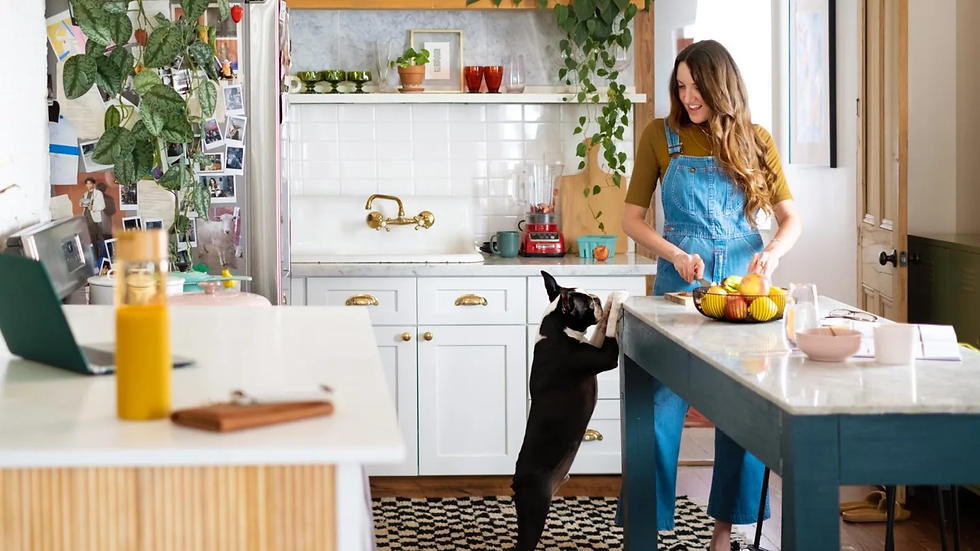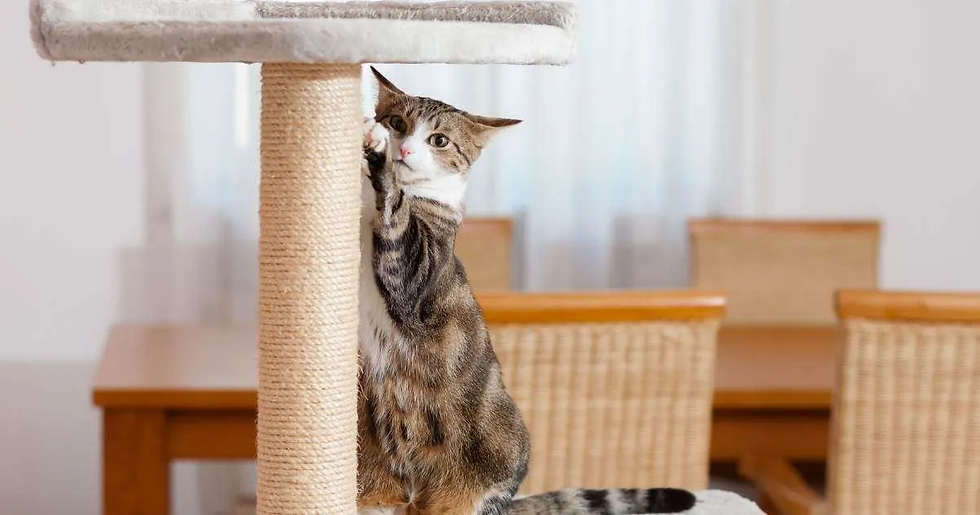The Pet Policies That Attract Tenants: How Pet-Friendly Rentals Boost Occupancy and Tenant Satisfaction
- Maria V.
- Sep 25, 2025
- 11 min read
Updated: Sep 30, 2025
In today’s rental market, one of the most effective ways to appeal to a wider pool of tenants is by offering pet-friendly policies. With more than two-thirds of U.S. households owning pets—and similar trends seen globally—landlords and property managers who adapt their rental rules to accommodate furry companions are seeing increased occupancy rates, tenant satisfaction, and long-term retention.

Why Pet-Friendly Rentals Matter
For many renters, pets are not just companions—they are family. As a result, restrictive “no-pet” policies can significantly narrow the tenant pool, especially in competitive rental markets. With nearly 70% of U.S. households owning a pet, the demand for pet-friendly housing is stronger than ever.
Expanding the Tenant Pool
When landlords open their doors to pets, they instantly appeal to a broader demographic. Families with dogs, single professionals with cats, and even retirees with smaller pets all seek housing that accommodates their lifestyle. By offering flexibility, property owners can attract long-term tenants who are more likely to view the property as a true home.
Willingness to Pay More
Pet owners often expect to pay a premium for a rental that welcomes their animals. This can translate into slightly higher rents, pet deposits, or pet-related fees that help landlords offset potential risks. Many renters are willing to absorb these costs to secure a comfortable space where their pets are accepted.
Boosting Occupancy Rates
Vacancies are costly, and pet-friendly listings often fill faster because of the strong demand. In urban and suburban areas alike, allowing pets can make a property stand out among competing rentals. Higher occupancy means more consistent rental income and fewer turnover gaps for landlords.
Enhancing Tenant Satisfaction
A pet-friendly policy fosters goodwill between property managers and tenants. Residents who feel that their pets are welcome are more likely to renew leases, reducing turnover rates and the expenses that come with preparing a unit for new occupants.
Balancing Risks with Benefits
Of course, landlords must balance the benefits with the risks. Clear pet policies—such as weight limits, breed restrictions, or pet agreements—help protect the property while keeping tenants happy. Offering amenities like designated pet areas or pet waste stations can further minimize challenges and enhance the rental experience.
Pet-friendly rentals aren’t just a trend—they’re a practical strategy for boosting occupancy, reducing turnover, and creating satisfied tenants. By viewing pets as part of the family, landlords can tap into a large and loyal renter base while enjoying financial and operational advantages.
Benefits for Landlords and Property Managers
Higher Occupancy Rates: The Advantage of Pet-Friendly Rentals
One of the biggest challenges landlords face is keeping vacancy rates low. Empty units translate to lost income, additional marketing costs, and time spent preparing the property for the next tenant. For many property owners, one simple policy shift can make a significant difference: allowing pets.
Faster Leasing
Properties that allow pets tend to rent faster. Since a large portion of renters struggle to find housing that accommodates their animals, pet-friendly units stand out immediately in listings. For pet owners, the search for a suitable home can be stressful and limited. When they find a property that welcomes their pets, they are more likely to act quickly and secure the lease before someone else does.
Longer Tenancy
Pet-friendly rentals also benefit from longer lease terms and lower turnover. Moving is not only expensive but also difficult for tenants with pets, who often face a narrower range of housing options. As a result, tenants are more likely to stay in a property where they feel their entire household—including their pets—is welcome. This creates more stable and predictable occupancy rates for landlords.
Reduced Vacancy Costs
High vacancy rates can be a hidden drain on rental income. By offering a pet-friendly policy, landlords reduce the time units sit empty and ensure a more consistent cash flow. In competitive rental markets, this small adjustment can be the difference between a property that sits vacant and one that remains steadily occupied.
Building Tenant Loyalty
Tenants who find a pet-friendly rental often develop a stronger sense of loyalty toward the property and its management. When renters feel that their pets are valued, they are more likely to renew their leases, recommend the property to others, and treat the home as their long-term residence.
Pet-friendly rentals not only attract a broader pool of tenants but also drive faster leasing, higher occupancy, and greater tenant satisfaction. For landlords, allowing pets is more than a convenience—it’s a strategic decision that supports long-term profitability.

Increased Rental Income: The Financial Benefits of Pet-Friendly Policies
For landlords, one of the most compelling reasons to allow pets in rental properties is the potential for increased revenue. While pet ownership continues to rise, many tenants struggle to find suitable housing that accommodates their furry companions. By offering pet-friendly rentals, property owners not only widen their tenant pool but also unlock new income opportunities.
Pet Deposits and Fees
A common practice among landlords is charging a refundable pet deposit. This provides a financial safeguard in case of damage while assuring tenants that their funds will be returned if the property is well-maintained. Some landlords also implement non-refundable pet fees, which offer immediate income to help cover potential wear and tear.
Monthly Pet Rent
In addition to deposits, many landlords charge “pet rent”—a modest monthly fee per pet. While this fee is typically small enough to remain competitive, it adds up over time to create a consistent revenue stream. For example, a $25 monthly pet rent for one pet equates to $300 in additional income per year, per unit.
Competitive Advantage
Despite the added costs, tenants with pets are often willing to pay these fees because their housing options are limited. This willingness not only keeps the property competitive in the market but also positions it as a more attractive choice compared to rentals with restrictive no-pet policies.
Offsetting Risks While Boosting Profitability
Allowing pets does involve some risk, but the extra income from deposits, fees, and pet rent helps offset potential maintenance costs. In many cases, the financial gain exceeds the occasional expense, making pet-friendly policies a practical and profitable decision.
By introducing pet deposits, non-refundable fees, and monthly pet rent, landlords can significantly increase rental income without pricing themselves out of the market. With more tenants seeking pet-friendly housing, these policies create a win-win: tenants secure a welcoming home for their pets, and landlords enjoy stronger returns on their properties.
Tenant Retention: How Pet-Friendly Rentals Reduce Turnover
Tenant turnover is one of the most costly challenges landlords face. Each move-out requires cleaning, repairs, marketing, and sometimes weeks of lost rent while searching for the next tenant. One effective way to reduce this cycle is by adopting pet-friendly policies.
Why Pet Owners Stay Longer
Moving is stressful for anyone, but relocating with pets adds another layer of difficulty. Pet owners must consider transportation, restrictions in new housing, and the limited availability of pet-friendly options. Because of these challenges, tenants with pets are more inclined to remain in a home where their animals are welcome, resulting in longer lease terms.
Reduced Vacancy and Turnover Costs
When tenants stay longer, landlords save on the expenses of preparing and re-listing the property. Lower turnover means fewer marketing efforts, less frequent property wear from constant moving, and more consistent rental income. In markets with high competition, retaining tenants can be just as important as attracting them.
Building Tenant Loyalty
Allowing pets also helps strengthen the relationship between tenants and landlords. Tenants who feel that their entire household—including their pets—is valued are more likely to renew leases and recommend the property to friends or family. This loyalty not only supports retention but can also enhance the property’s reputation.
Long-Term Profitability
Consistent occupancy and reduced turnover translate into higher long-term profitability for landlords. Even if occasional pet-related maintenance costs arise, the financial benefits of keeping tenants longer typically outweigh the expenses.
Pet-friendly rentals create an environment where tenants feel secure and respected, encouraging them to stay longer and reducing costly turnover. For landlords, this translates into steadier income, lower expenses, and stronger tenant relationships.

Tenant Retention: How Pet-Friendly Rentals Reduce Turnover
Tenant turnover is one of the most costly challenges landlords face. Each move-out requires cleaning, repairs, marketing, and sometimes weeks of lost rent while searching for the next tenant. One effective way to reduce this cycle is by adopting pet-friendly policies.
Why Pet Owners Stay Longer
Moving is stressful for anyone, but relocating with pets adds another layer of difficulty. Pet owners must consider transportation, restrictions in new housing, and the limited availability of pet-friendly options. Because of these challenges, tenants with pets are more inclined to remain in a home where their animals are welcome, resulting in longer lease terms.
Reduced Vacancy and Turnover Costs
When tenants stay longer, landlords save on the expenses of preparing and re-listing the property. Lower turnover means fewer marketing efforts, less frequent property wear from constant moving, and more consistent rental income. In markets with high competition, retaining tenants can be just as important as attracting them.
Building Tenant Loyalty
Allowing pets also helps strengthen the relationship between tenants and landlords. Tenants who feel that their entire household—including their pets—is valued are more likely to renew leases and recommend the property to friends or family. This loyalty not only supports retention but can also enhance the property’s reputation.
Long-Term Profitability
Consistent occupancy and reduced turnover translate into higher long-term profitability for landlords. Even if occasional pet-related maintenance costs arise, the financial benefits of keeping tenants longer typically outweigh the expenses.
Pet-friendly rentals create an environment where tenants feel secure and respected, encouraging them to stay longer and reducing costly turnover. For landlords, this translates into steadier income, lower expenses, and stronger tenant relationships.
Best Practices for Pet Policies
Creating Fair Pet Policies: Balancing Tenant Needs and Property Protection
As pet ownership continues to rise, more landlords are recognizing the value of pet-friendly rentals. However, opening properties to pets does not mean sacrificing safety, cleanliness, or property value. By implementing clear, fair policies, landlords can welcome pet-owning tenants while maintaining proper safeguards.
Breed and Size Guidelines
Instead of blanket “no-pet” rules or broad prohibitions, landlords can set reasonable restrictions that match the property type. For example, larger breeds may not be suited for small apartments with limited outdoor access, while certain multi-unit buildings may benefit from guidelines that limit the number of pets per unit. Thoughtful restrictions help balance tenant freedom with property protection.
Pet Agreements and Documentation
A clear pet agreement in the lease can outline expectations for tenants, covering areas such as noise, waste disposal, and damage responsibility. Requiring proof of vaccinations and licensing not only protects the property but also ensures the safety of other residents and pets in the community.
Deposits, Fees, and Pet Rent
Financial safeguards such as refundable pet deposits or modest monthly pet rent can offset potential damage while keeping the rental competitive. These fees also encourage tenants to take responsibility for their pets’ impact on the property.
Amenities That Reduce Risk
Providing simple pet-friendly amenities can minimize problems. Designated pet areas, waste stations, and durable flooring materials can help reduce wear and tear, while fostering a positive experience for both tenants and landlords.
Building Trust and Retention
Clear, fair policies communicate to tenants that their pets are welcome as part of the household, while also assuring landlords that protections are in place. This balance promotes stronger landlord-tenant relationships, higher tenant satisfaction, and longer lease terms.
Pet-friendly rentals don’t have to mean greater risks. With well-structured policies—such as breed and size guidelines, pet agreements, and reasonable fees—landlords can protect their investments while attracting a wider pool of responsible tenants.

Pet Deposits and Fees: Ensuring Transparency and Compliance
For landlords, allowing pets can bring both financial benefits and additional responsibilities. One of the most effective ways to balance tenant demand with property protection is through pet deposits and fees. When managed properly, these charges provide safeguards against potential damage while keeping rental practices fair and transparent.
The Role of Pet Deposits and Fees
Pet deposits and fees serve as financial security for landlords, covering costs that may arise from pet-related wear and tear. A refundable pet deposit reassures tenants that their money will be returned if the property is well-maintained, while non-refundable fees offer upfront protection against potential damage. Both approaches help landlords manage risks without discouraging responsible pet owners.
Transparency Builds Trust
Tenants are more likely to accept additional costs if they are clearly communicated upfront. Landlords should provide detailed explanations of all pet-related charges—including whether they are refundable, what they cover, and how they are collected. Transparent practices not only build trust but also reduce disputes at the end of a lease.
Compliance with Local Laws
It’s essential for landlords to understand and comply with local and state laws regarding pet deposits and fees. In some jurisdictions, there may be limits on how much landlords can charge, or rules requiring separate accounting for refundable deposits. Clear compliance ensures fair treatment for tenants and prevents costly legal issues down the road.
Balancing Protection and Market Competitiveness
While deposits and fees protect landlords, they must remain reasonable to keep the property competitive in the rental market. Excessive charges may drive tenants toward other listings, while fair and transparent fees can make a property more attractive to responsible pet owners.
Pet deposits and fees are valuable tools for landlords, offering a balance between property protection and tenant satisfaction. By keeping costs transparent and ensuring compliance with local laws, landlords can create a pet-friendly environment that benefits both parties.
Behavior Expectations: Setting Clear Rules for Pets in Rental Properties
As more landlords open their doors to pet-owning tenants, setting clear behavior expectations becomes essential. While pets bring comfort and companionship, they can also impact noise levels, cleanliness, and shared spaces if not properly managed. Establishing well-defined rules helps protect the property, promote tenant harmony, and ensure a positive living environment for everyone.
Noise Control
Barking dogs, loud play, or restless pets can disturb neighbors and create tension within a community. Landlords should outline clear noise policies in the lease agreement, specifying quiet hours and consequences for repeated disturbances. By setting expectations early, tenants are encouraged to be proactive in managing their pets’ behavior.
Cleanliness Standards
Maintaining cleanliness is crucial to preserving property value and tenant satisfaction. Rules should require tenants to clean up after their pets, both inside the unit and in shared outdoor areas. Providing waste disposal stations in multi-family properties can further encourage compliance and make upkeep easier for all residents.
Shared Space Usage
In multi-unit buildings, shared spaces such as hallways, elevators, and courtyards must remain safe and comfortable for all tenants. Policies should require pets to be leashed in common areas, prohibit unsupervised roaming, and establish guidelines for using designated pet-friendly zones. These rules prevent accidents, reduce liability, and ensure respect for non-pet-owning residents.
Fostering Community Harmony
Clear behavior expectations not only protect the property but also promote a stronger sense of community. When all tenants know the rules and see them enforced fairly, they are more likely to feel comfortable and valued in their living environment.
By outlining specific rules for noise, cleanliness, and shared space usage, landlords can balance the needs of pet owners with the rights of all tenants. Transparent expectations reduce conflicts, enhance tenant satisfaction, and create a well-managed rental property where everyone benefits.

Amenities and Safety: Enhancing Pet-Friendly Rental Properties
As the demand for pet-friendly housing continues to grow, landlords and property managers can set their properties apart by offering amenities and safety features designed with pets in mind. These additions not only attract responsible pet owners but also create a more enjoyable and harmonious living environment for all tenants.
Pet Waste Stations
Providing designated waste disposal stations in outdoor areas encourages tenants to clean up after their pets and helps maintain a clean, sanitary property. This small investment reduces maintenance burdens for landlords and ensures shared spaces remain pleasant for everyone.
Safe Play Areas
Designated pet play zones or fenced-in dog runs give pets a secure place to exercise and socialize. For multi-family properties, these areas minimize wear and tear on lawns or common grounds while offering a convenience that many pet owners actively seek in a rental.
Access to Pet Services
Proximity to pet-friendly amenities, such as grooming salons, veterinary clinics, or pet supply stores, adds value to a rental property. In some cases, landlords may even partner with local businesses to offer tenant discounts, further enhancing tenant satisfaction and loyalty.
Promoting Safety
Safety is paramount in pet-friendly rentals. Rules requiring leashes in common areas, secure fencing, and durable flooring can all help protect both tenants and property. These precautions reduce risks of accidents or damage, giving landlords peace of mind while ensuring tenants feel confident their pets are welcome.
Competitive Advantage
Properties that go beyond simply “allowing pets” and instead provide thoughtful amenities often rent faster and enjoy higher retention rates. For many pet owners, these features transform a rental into a true home.
Amenities and safety features such as waste stations, safe play areas, and access to nearby pet services help landlords attract and retain tenants while protecting their property. By investing in these practical additions, rental properties become more competitive and appealing in today’s pet-focused housing market.
Sources:
American Pet Products Association (APPA), 2024 Pet Ownership Statistics
Zillow
https://www.revolutionrentalmanagement.com/property-management-blog/pets-or-no-pets
Renting Housing Journal



Comments